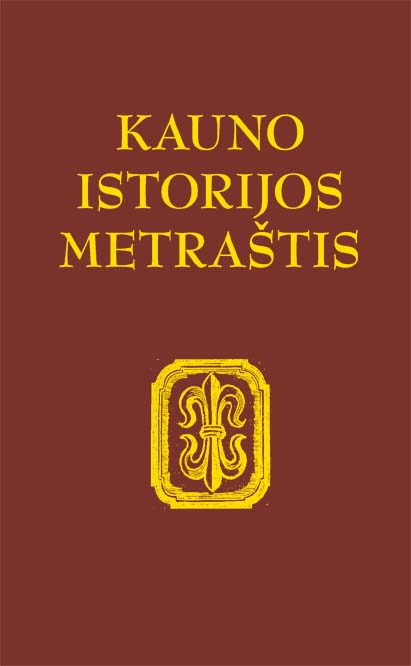Kościół Trynitarzy w Wilnie. Uwagi o jego budowaniu
The Trinitarian Church in Vilnius. Some Remarks on its Construction
Author(s): Karol GuttmejerSubject(s): Christian Theology and Religion, Cultural history, History of Church(es), 17th Century
Published by: Vytauto Didžiojo Universitetas
Keywords: Vilnius Trinitarian Church; Church; Mausoleum; Vault structure; Giovanni Battista Frediani; Churches baroque architecture 17th century;
Summary/Abstract: The Trinitarian church in Vilnius was built between 1694 and 1716 as the foundation of Hetman Kazimierz Jan Sapieha by an anonymous architect. The article addresses three main issues. The first is the plan of the church and the function of a family mau¬soleum. A regular octagon without a separate presbytery on a compact plan, with altar recesses cut out in the thickness of the walls, indicates more the function of a family mausoleum than a religious church. All Trinitarian churches have a separate presbytery. Compositive, spatial connection with the palace park stands for ideal connection with the residency of Sapiecha. As it happened, however, the founder was not buried here, and the church did not play the role of a family mausoleum. The second issue is the structure of the vault. It has a span of 18.20–19.60 metres. The vault is made of eight domical vaults, similar to the “dome” of the Florence Cathedral of Santa Maria del Fiore and the Cappella dei Principi. The vault’s layer is about 1.50 metre thick at the base and 0.60 metre thick under the lantern. Such mass and weight would pose a threat to the building’s statics. Probably, it is not a monolithic structure but a two-layer one, similar to the two Florentine vaults mentioned above. It is based on a framework of monolithic buttresses of trapezoidal section. Between them, there are two surfaces of vault cells adjoining at the base of the lantern. The verification of this thesis can be established through examination with a thermal imaging camera or architectural tests. The third issue is an angular arrangement of towers visible in a straight view. This arrangement is due to the fact that they adjoin the diagonal walls of the octagonal body, and are not inscribed into the façade line. Thus, they do not resemble the solution used in St Peter’s Church in Vienna or the Trinitarian Church in Bratislava, both later than the Vilnius one. There, the towers do not adjoin the oval nave, flanking the preceding span of the inter-tower vestibule instead, and forming a screen façade. Researchers thought that the Trinitarian towers were added later. However, the parts of both towers with preserved plaster and entablature, visible from the attic of the nave vault, testify to the simultaneous construction of the towers with the nave body. The structure of the church, especially the vaults, suggests that its designer and builder was military engineer Giovanni Batista Frediani. / Vilniaus Trinitorių bažnyčia, funduota etmono Kazimiero Jonas Sapiegos, pastatyta 1694–1716 m. pagal nežinomo architekto projektą. Straipsnyje aptariamos trys pagrindinės problemos. Pirmiausia bažnyčios planas ir jos kaip šeimos mauzoliejaus paskirtis. Kompaktiškas taisyklingo aštuonkampio planas be atskiros presbiterijos, su sienose esančiose nišose įrengtais altoriais labiau byloja apie šeimos mauzoliejaus, o ne religinio kulto paskirtį. Visos Trinitorių bažnyčios turi atskiras presbiterijas. Šios bažnyčios sudėtinė erdvinė kompozicija Sapiegų rūmų parke byloja apie jos tobulą ryšį su Sapiegų rezidencija. Tačiau nutiko taip, kad fundatorius nebuvo joje palaidotas ir bažnyčia netapo šeimos mauzoliejumi. Antroji aptariama problema – skliautų konstrukcija. Atstumas tarp atramų – 18,20–19,60 metro. Skliautas sudarytas iš aštuonių kupolinių skliautų – panašiai kaip Florencijos Santa Maria del Fiore katedros ir Kunigaikščių koplyčios (it. Cappella dei Principi) skliautai. Skliauto storis yra 1,50 metro prie bazės ir 0,60 metro po žibintu. Tokia masė ir svoris turėtų kelti grėsmę pastato stabilumui. Tačiau veikiausiai tai yra ne monolitinė, o dvisluoksnė konstrukcija, panaši į minėtųjų Florencijos skliautų. Ji paremta monolitinių trapecijos formos kontraforsų karkasu. Tarp jų yra dvisluoksnis kupolinių skliauto elementų paviršius, besiribojantis prie žibinto bazės. Patikrinti šią hipotezę galima būtų atlikus termovizinę diagnostiką arba architektūrinius tyrimus. Trečia problema yra kampinis bokštų išdėstymas, matomas iš priekio. Tokį išdėstymą lemia tai, kad jie ribojasi su įstrižomis aštuonkampio korpuso sienomis, o ne integruoti į fasado plokštumą. Taigi jie neprimena sprendimo, naudojamo Vienos Šv. Petro bažnyčioje ar Bratislavos Trejybės bažnyčioje (abi pastatytos vėliau nei Vilniaus). Ten bokštai nesiriboja su ovalia nava, bet yra įkomponuoti abipus bažnyčios prieangio ir tokiu būdu sudaro vientisą fasado vaizdą. Tyrėjai manė, kad Trejybės bokštai buvo pristatyti vėliau. Tačiau abiejų bokštų dalys su išlikusiu tinku ir antablementu, matomos iš navos skliauto atiko, liudija, kad bokštai buvo statomi vienu metu su navos korpusu. Bažnyčios konstrukcija, ypač skliautai, leidžia manyti, kad jos projektuotojas ir statytojas buvo karo inžinierius Džovanis Batista Fredianis (Giovanni Battista Frediani).
Journal: Kauno istorijos metraštis
- Issue Year: 2022
- Issue No: 20
- Page Range: 257-283
- Page Count: 27
- Language: Polish

